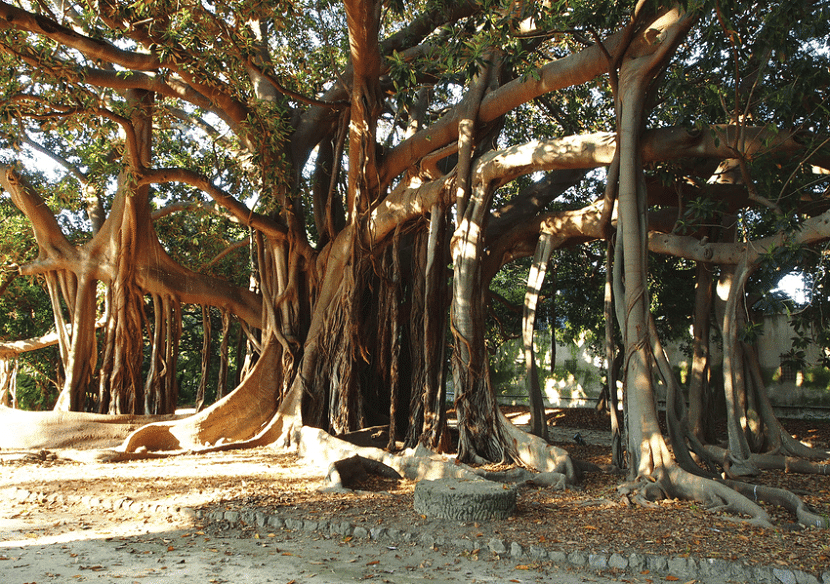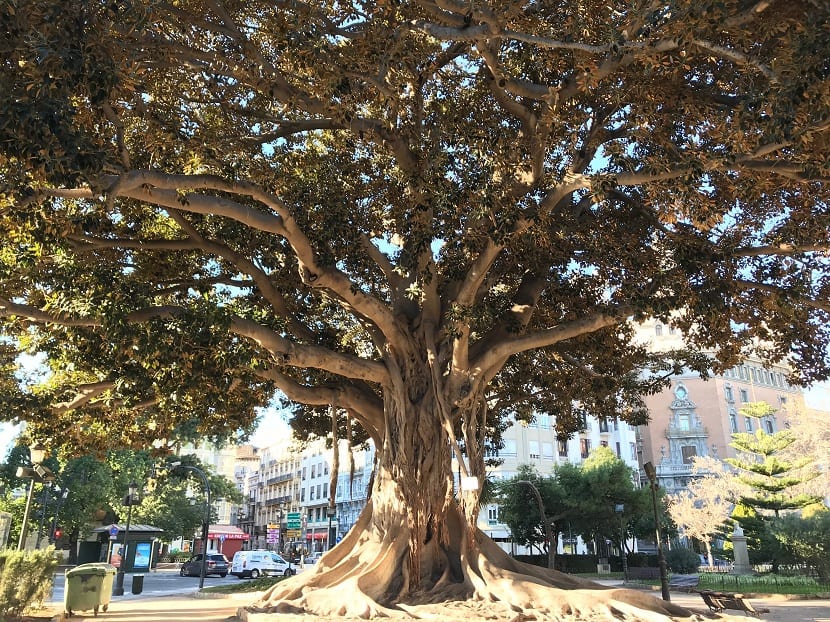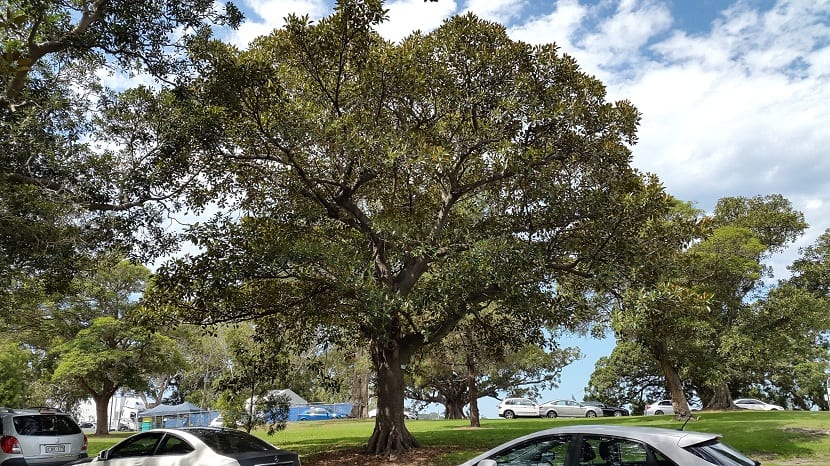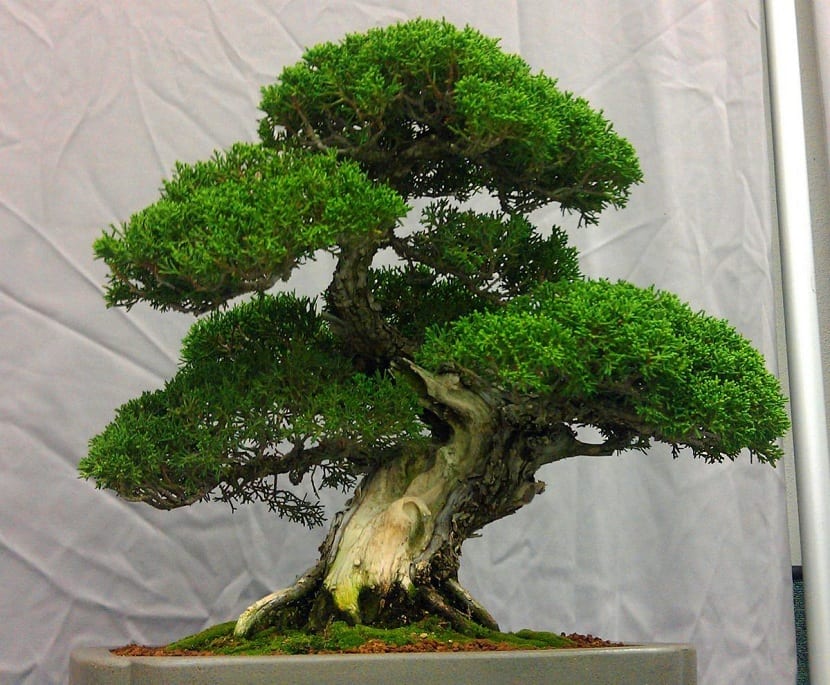
One of the evergreen trees that is perfectly decorating cities and urban centers is the Ficus macrophylla. It is a tree that belongs to the Moraceae family and is known by its common name black fig or black fig tree. It is capable of reaching up to 60 meters in height if it grows in good conditions, so it will be a decorative element on a large scale.
In this article we are going to show you what are its main characteristics and care that it needs.
Key features

It is a tree that comes from Australia and is mainly found outdoors. It is quite common to see it in parks and gardens because of its decorative bearing and the ease with which it is grown.. There are people who use it as a decorative element indoors using the specimens in bonsai mode.
This type of ficus grows in areas near the sea that are warmer. Its common name comes from the natural range it has in Australia. It is found in Moreton Bay in Australia. It is a species that does not tolerate the cold well because it is used to having the high temperatures of the Australian area. Thus, if the frosts are below -3 degrees frequently, you can die. If, on the other hand, we find a specific frost, it can survive without problems.
If we give it the necessary care, it is capable of becoming a huge tree in a relatively short time. Thanks to its enormous size and the morphology of the trunk it is an excellent decorative for parks and gardens. In addition, it is used as an extra shade contribution in hotter areas and in picnic areas.
Caring for the Ficus macrophylla

Although it is quite easy to care for and is generally resistant to numerous pests and diseases, it does not mean that we can leave it without any care at all. Usually, ornamental plants that are used in public places tend to be easier to care for, since you cannot pay special attention to each one of them. If we choose plants with very demanding care, we will not be able to attend it with the same frequency as if we have it in private decorative elements such as indoors and in gardens.
For the Ficus macrophylla develops in good condition you will need well-drained, moist soil and in an area where there is plenty of natural light. This light can be perfectly direct sun rays or semi-shade. It depends on the location that we want to give it depending on the utility. For example, if we want to put it in a park to create recreational or picnic areas, we are interested in placing them in an area of direct sun to have a shaded space where to put people.
Development reaches its best stage when the soil has a neutral pH, although it also lives in slightly acidic and alkaline soils. It has a huge root system. This causes the need to have a planning system for the space where it will be located because it will have to be able to develop in a normal way. If we choose to place it on an urban walk, we must ensure that there is enough space for the roots to extend as far as necessary.
As for watering, it does not need too much watering, since it is a drought resistant plant. It is perfect to place it outdoors where the rains are not very frequent, that they will also be able to live and develop well.
Flowers and fruits

El Ficus macrophylla it is a quite showy tree that has a well-populated crown. The leaves have an elongated, oval appearance and are large. They can measure between 15-30 cm. It does not lose its leaves with the passing of the seasons as it is evergreen, although it is continually renewing them.
The flowers are quite small compared to its leaves. They only measure between 2 and 3 cm. They are forming whitish yellow sycopes and do not usually stand out. Being such a large tree in size and with large leaves, small flowers often go unnoticed.
The fruit of this Ficus is a type of fig of a small size. TThey are still only about 2,5 cm in diameter. They are green at first, but as they mature, they turn purple. The color of the fig is not always uniform, since we can find some light spots along its surface. They are edible but not at all rich. It is not usually included in any gastronomy since the flavor leaves much to be desired.
Although it is not food for humans, it is very useful for birds. Many birds and other small wild animals eat figs.
Indoor cultivation

Even if we grow it indoors and it is shaped like a bonsai, it will need a large pot so that the roots have enough space to grow normally. It can be pruned at any time of the year, but it is in late spring and early summer when it is most suitableSince the warm weather will help it to regrow more quickly. In this way we also allow the cuttings we transplant to grow more safely.
Excess water must be avoided at all costs so that the roots do not rot. It is advisable to use a suitable drainage system. It is convenient to water once a week and you have to see if the land is flooded or not. If there is a large amount of accumulated water, it can favor the appearance of pests and diseases.
The plant must be located in areas where it has significant lighting that can guarantee its growth. It is highly recommended to have the humidity of the environment high enough so that it can grow well. We can keep a full container of water next to the pot to provide more humidity or we can spray the leaves of the plant at its base to help maintain humidity.
I hope that with these tips you can take care of the Ficus macrophylla and enjoy its beauty outdoors or at home.